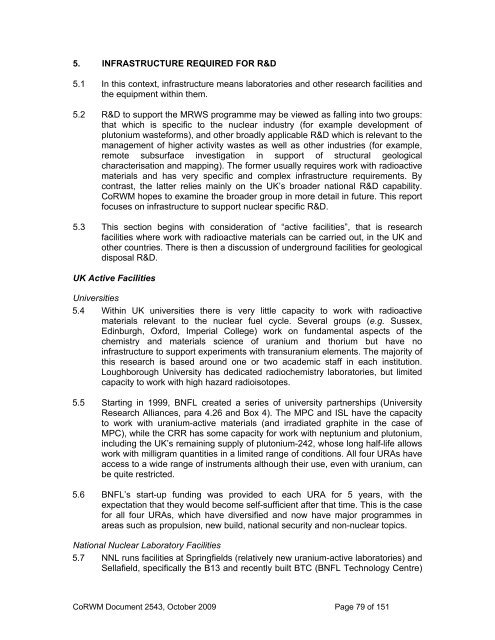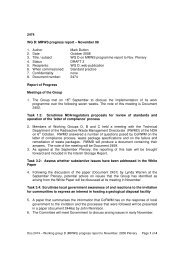2009 Report to Government on National Research and
2009 Report to Government on National Research and
2009 Report to Government on National Research and
- TAGS
- corwm.decc.gov.uk
Create successful ePaper yourself
Turn your PDF publications into a flip-book with our unique Google optimized e-Paper software.
5. INFRASTRUCTURE REQUIRED FOR R&D<br />
5.1 In this c<strong>on</strong>text, infrastructure means labora<str<strong>on</strong>g>to</str<strong>on</strong>g>ries <strong>and</strong> other research facilities <strong>and</strong><br />
the equipment within them.<br />
5.2 R&D <str<strong>on</strong>g>to</str<strong>on</strong>g> support the MRWS programme may be viewed as falling in<str<strong>on</strong>g>to</str<strong>on</strong>g> two groups:<br />
that which is specific <str<strong>on</strong>g>to</str<strong>on</strong>g> the nuclear industry (for example development of<br />
plu<str<strong>on</strong>g>to</str<strong>on</strong>g>nium wasteforms), <strong>and</strong> other broadly applicable R&D which is relevant <str<strong>on</strong>g>to</str<strong>on</strong>g> the<br />
management of higher activity wastes as well as other industries (for example,<br />
remote subsurface investigati<strong>on</strong> in support of structural geological<br />
characterisati<strong>on</strong> <strong>and</strong> mapping). The former usually requires work with radioactive<br />
materials <strong>and</strong> has very specific <strong>and</strong> complex infrastructure requirements. By<br />
c<strong>on</strong>trast, the latter relies mainly <strong>on</strong> the UK’s broader nati<strong>on</strong>al R&D capability.<br />
CoRWM hopes <str<strong>on</strong>g>to</str<strong>on</strong>g> examine the broader group in more detail in future. This report<br />
focuses <strong>on</strong> infrastructure <str<strong>on</strong>g>to</str<strong>on</strong>g> support nuclear specific R&D.<br />
5.3 This secti<strong>on</strong> begins with c<strong>on</strong>siderati<strong>on</strong> of “active facilities”, that is research<br />
facilities where work with radioactive materials can be carried out, in the UK <strong>and</strong><br />
other countries. There is then a discussi<strong>on</strong> of underground facilities for geological<br />
disposal R&D.<br />
UK Active Facilities<br />
Universities<br />
5.4 Within UK universities there is very little capacity <str<strong>on</strong>g>to</str<strong>on</strong>g> work with radioactive<br />
materials relevant <str<strong>on</strong>g>to</str<strong>on</strong>g> the nuclear fuel cycle. Several groups (e.g. Sussex,<br />
Edinburgh, Oxford, Imperial College) work <strong>on</strong> fundamental aspects of the<br />
chemistry <strong>and</strong> materials science of uranium <strong>and</strong> thorium but have no<br />
infrastructure <str<strong>on</strong>g>to</str<strong>on</strong>g> support experiments with transuranium elements. The majority of<br />
this research is based around <strong>on</strong>e or two academic staff in each instituti<strong>on</strong>.<br />
Loughborough University has dedicated radiochemistry labora<str<strong>on</strong>g>to</str<strong>on</strong>g>ries, but limited<br />
capacity <str<strong>on</strong>g>to</str<strong>on</strong>g> work with high hazard radioiso<str<strong>on</strong>g>to</str<strong>on</strong>g>pes.<br />
5.5 Starting in 1999, BNFL created a series of university partnerships (University<br />
<strong>Research</strong> Alliances, para 4.26 <strong>and</strong> Box 4). The MPC <strong>and</strong> ISL have the capacity<br />
<str<strong>on</strong>g>to</str<strong>on</strong>g> work with uranium-active materials (<strong>and</strong> irradiated graphite in the case of<br />
MPC), while the CRR has some capacity for work with neptunium <strong>and</strong> plu<str<strong>on</strong>g>to</str<strong>on</strong>g>nium,<br />
including the UK’s remaining supply of plu<str<strong>on</strong>g>to</str<strong>on</strong>g>nium-242, whose l<strong>on</strong>g half-life allows<br />
work with milligram quantities in a limited range of c<strong>on</strong>diti<strong>on</strong>s. All four URAs have<br />
access <str<strong>on</strong>g>to</str<strong>on</strong>g> a wide range of instruments although their use, even with uranium, can<br />
be quite restricted.<br />
5.6 BNFL’s start-up funding was provided <str<strong>on</strong>g>to</str<strong>on</strong>g> each URA for 5 years, with the<br />
expectati<strong>on</strong> that they would become self-sufficient after that time. This is the case<br />
for all four URAs, which have diversified <strong>and</strong> now have major programmes in<br />
areas such as propulsi<strong>on</strong>, new build, nati<strong>on</strong>al security <strong>and</strong> n<strong>on</strong>-nuclear <str<strong>on</strong>g>to</str<strong>on</strong>g>pics.<br />
Nati<strong>on</strong>al Nuclear Labora<str<strong>on</strong>g>to</str<strong>on</strong>g>ry Facilities<br />
5.7 NNL runs facilities at Springfields (relatively new uranium-active labora<str<strong>on</strong>g>to</str<strong>on</strong>g>ries) <strong>and</strong><br />
Sellafield, specifically the B13 <strong>and</strong> recently built BTC (BNFL Technology Centre)<br />
CoRWM Document 2543, Oc<str<strong>on</strong>g>to</str<strong>on</strong>g>ber <str<strong>on</strong>g>2009</str<strong>on</strong>g> Page 79 of 151



